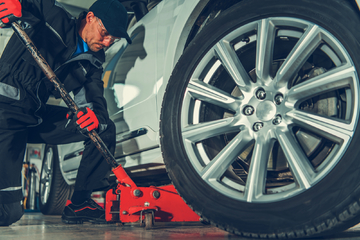
Floor jacks are common tools home mechanics use to lift and lower vehicles. A floor jack is a simple tool, but if used incorrectly, a floor jack can be dangerous. Some simple tips can help make sure using a floor jack at home is safe.
Common Types of Automotive Floor Jacks and How They Work
Scissor Jack
The most common type of floor jack used in the automotive industry is a scissor jack. Most often, a scissor jack is what the manufacturer included with a vehicle along with a spare tire. scissor jacks use a threaded rod that draws the arms of the jack together and raising the jacking pad. While effective for quickly lifting a vehicle, scissor jacks are among the most dangerous to use and can fail catastrophically when not used correctly. Home mechanics should always use a scissor jack of stable, flat ground for safety.
Bottle Jack
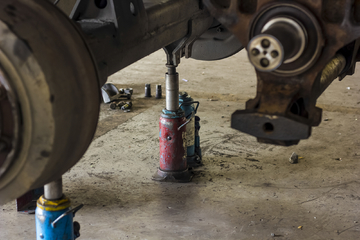 A bottle jack can lift large amounts of weight, but must be carefully positioned. Bottle jacks can fall over under load.
A bottle jack can lift large amounts of weight, but must be carefully positioned. Bottle jacks can fall over under load.A bottle jack is a cylindrical jack that is operated with a pump lever. Bottle jacks are capable of providing massive amounts of lifting power from a small package, but are significantly heavier than scissor jacks. A bottle jack uses a hydraulic ram to pressurize a lifting pad. A bottle jack will usually only give the mechanic a small amount of lift. Bottle jacks can be dangerous because the small base size does not allow sideways motion, and like a scissor jack, must be operated on flat, level ground.
Floor Jack
A floor jack typically uses a hydraulic ram mounted horizontally that raises an arm with a lifting pad. Swiveling wheels called casters allow the jack to move slightly while lifting so the arc of the lifting arm is not a problem. Smaller floor jacks are designed by the manufacturer to use a rectangular peg that can be turned to release pressure on the hydraulic ram. Larger jacks integrate this feature into the handle. A floor jack is capable of lifting vehicles easily and quickly, and can provide excellent under car access. A floor jack is the safest of the common automotive jacks.
Floor Jack Safety
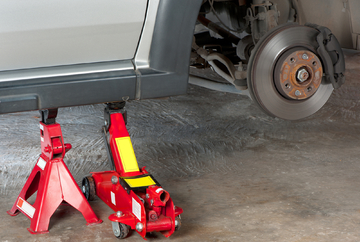 Always use a Jack Stand when working on a car. Never work under a car supported only by a floor jack.
Always use a Jack Stand when working on a car. Never work under a car supported only by a floor jack.Improper use of a floor jack can be very dangerous. Vehicles that are not properly supported by the operator can fall, damaging the vehicle and injuring or killing anyone unfortunate enough to be in the way. Some simple safety steps can make the use of floor jacks very safe for the typical home mechanic. Never work on or under a car or truck supported only by a jack. The only situation where a jack support is probably unlikely is when changing a tire on the side of the road using the factory scissor jack.
A trick to help make side-of-the-road tire repairs safer is to remove the spare prior to lifting the vehicle and placing the spare under the vehicle while lifting. Once the flat tire is removed, it can be slid under the vehicle until the spare is installed. This will allow some clearance in case the jack fails and could be the difference between an injury and death.
Always lift and lower vehicles slowly, checking to make sure the lifting pad is not slipping and that the jack is perpendicular to the lifting point to avoid collapse. Never release the pressure all at once. The vehicle can drop rapidly and become damaged, fall off jack supports on other parts of the vehicle, and can cause injuries.
Vehicle Jacking Points
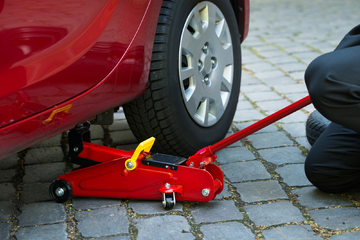 Use a Service and Repair manual to determine the correct jacking points for your car.
Use a Service and Repair manual to determine the correct jacking points for your car.The operator must figure out the best location for the jack before lifting the vehicle with a floor jack. Many cars today will have specific areas for lifting, called jacking points. A high-quality service and repair manual for the vehicle will identify safe jacking points.
Many cars today are built using unit body construction, called unibody in the automotive industry. This design uses the body panels of the vehicle to provide strength rather than relying on a traditional frame. Unibody vehicles must be lifted in the proper places with floor jacks to avoid flexing the body. The best places to lift a unibody car typically are the areas near the back of the engine compartment where structural members support the front end of the car. Similar points in the rear are useful for lifting the back of the car.
Many trucks use a traditional frame to support the body. You can jack trucks up along the frame rails safely.
Finding Safe Jacking Points Without a Manual
You should always know where the jacking points for your car are located. You should only raise a vehicle by the suspension when necessary. While the suspension is strong usually strong enough to lift the vehicle from, the uneven surfaces increase the likelihood of dropping a vehicle.
Never lift a vehicle by the center of the rear axle. Many people do this regularly, and even shops do it, but it is not safe. Lifting from the center applies force to the axle shafts and can damage bearings, seals, and cause retainer clip failures that dislodge the axle shaft. Typically, the center of the rear axle has a round case that is not a safe point to lift from, as the vehicle may slip sideways and fall.
The Floor Jacks Sidekick- Jack Stands
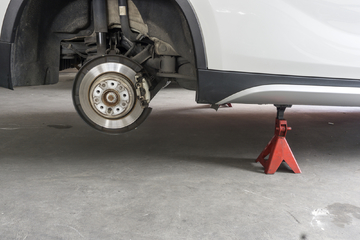 A sturdy, well-made set of jack stands should be purchased along with a floor jack. Stands are essential safety equipment.
A sturdy, well-made set of jack stands should be purchased along with a floor jack. Stands are essential safety equipment.A floor jack is great for lifting a car, but never, ever, ever work under a car supported only by a jack stand. This is critically important. Even a high-quality hydraulic floor jack has the potential to fail, and when they do, there is no warning and not time to get out from under a car. Bottle jacks and scissor jacks are even more dangerous, as the small base design does not allow for side loaded forces that can bend, break, or topple these types of jacks.
A jack stand is a very simple piece of equipment. They are typically steel with an adjustable lever to set the height. Manufacturers rate jack stands for the amount of weight they can support safely. A pair of jack stands is a minimum need before working on any supported vehicle.
Pay close attention to jack stands, particularly heavily used ones. In some cases, the metal can become fatigued and allow the jack stand to fail. This is a dangerous and terrifying situation I have personal experience with. As with a failing jack, a failing stand will not allow time to get out of the way.
What Size Floor Jack Do I Need?
It is important to know how much your vehicle weighs before buying a floor jack and jack stands. Typically, manufacturers rate floor jacks for 1.5 tons, 2 tons, 3 tons and more. Floor jacks become larger, heavier, and usually require more clearance the larger they get.
Today, many companies sell lightweight “racing” jacks often made from reinforced aluminum that allow low clearance and decent lift in a portable package. These jacks are fantastic for lowered cars and many modern cars that have low clearance. A vehicle's weight can be a factor, so make sure a racing jack is capable of lifting your vehicle.
A service and repair workshop manual will typically list the vehicle weight. A jack that is capable of lifting more than half the weight of the vehicle or more will be the easiest to use.
How Much Do Floor Jacks and Stands Cost?
A quality floor jack and stands can run from less than $50 to several hundred dollars depending on the size, type, and manufacturer. It typically is not necessary to buy a 3 ton jack for a typical passenger car. Likewise, a 1 ton aluminum racing jack is not appropriate for working on full-size trucks. Buying the right jack and stands is usually a one-time purchase, as these tools will last a lifetime if cared for properly.
